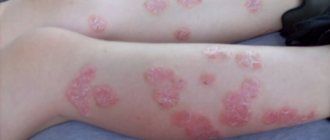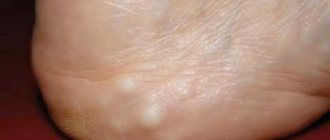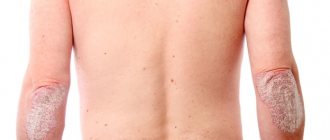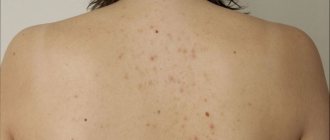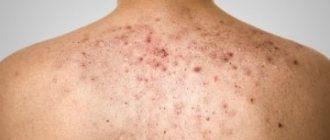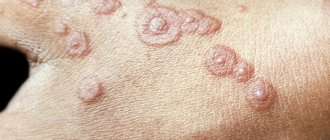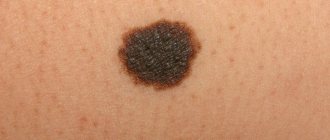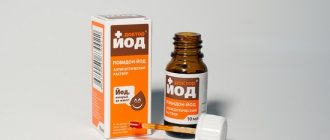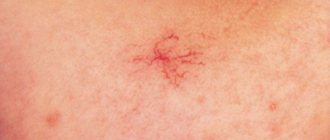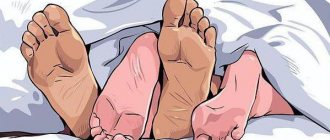Why does a rash occur?
Doctors are looking for an answer to this question, but there is not much reliable data about the disease, and for this reason it is difficult to treat.
It is known that predisposition to psoriasis is inherited. Also, psoriasis on the body can be triggered by inflammatory processes occurring in the body. At the same time, in places where inflammation is localized, cells divide especially quickly, and the old ones do not have time to die.
The skin thickens, the affected area takes on the appearance of a plaque that peels off. Keratinocytes accumulate in the neoplasms and blood vessels are formed, supplying the papules with oxygen and nutrients.
General information: what is a rash?
Rashes are elements of any size that affect the skin or mucous membranes under the influence of various pathological changes in the body. The rash varies in color, structure and general appearance. Among the primary (initial) types, doctors distinguish the following.
- Nodules (papules) are swellings, the diameter of which varies from 1 mm to 3 cm. The tubercles can be palpated.
- Pustule (ulcer) – the element contains pus.
- Blister - pink, cavity-free elements. The difference is the unbearable itching.
- Spots are local changes in the top layer of skin.
- Bubbles (sizes greater than 0.5 cm). Inside the element there is serous fluid.
- Hemorrhage - points that appear after subcutaneous hemorrhage. The group also includes spots similar to lichen.
Classification and clinical features
Most often, the disease manifests itself as specific red rashes. The rash consists of dry rashes located above the surface of the skin - papules.
Papules can merge with each other. Histological examination of the elements of the rash reveals areas of chronic inflammation, excessive growth of lymphocyte cells, macrophages and skin cells.
In addition, new small vessels form in the plaques.
Most often, the disease begins at a young age. A third of patients indicate the onset of the disease in the period from 15 to 20 years. Psoriasis is a chronic dermatosis. There are pustular and non-pustular forms.
The non-pustular form includes:
- Simple, also known as vulgar psoriasis.
- Psoriatic erythroderma.
The pustular form includes:
- Generalized pustular form.
- Palmoplantar shape.
- Annular form.
- Chronic psoriatic acrodermatitis.
- Herpetic psoriatic impetigo.
Also not included in the classification:
- Drug-induced psoriasis, that is, a disease induced by taking medications.
- “Reverse” form of psoriasis, in which the rashes are located on the flexor surfaces of the limbs.
- Napkin's disease.
- Seborrheic psoriasis.
Red spots on the skin
Every person has had strange spots on their skin at least once. Red spots appear for many reasons. However, they can be a slight irritation and indicate a deadly condition. If changes in the skin are observed along with fever, swelling, pain, itching, then it is important to seek help in time.
- Allergies to foods, sunlight, household chemicals, medications.
- Dermatitis.
- Lack of vitamins (seasonal).
- Low immunity.
- Infections.
- STD.
- Stress.
People, especially men, do not always pay attention to changes in skin tone in certain places. The reason for their appearance may be various factors. It is important to diagnose a provocateur. By eliminating it, the stains will also disappear. In the stronger half of humanity, red marks are more often associated with the following “pathogens”:
- Poor nutrition, frequent snacking.
- Allergy.
- Stress, nervous tension.
- Alcohol, smoking.
A red rash signals a malfunction of the internal organs and the hormonal system. In men, problems with the heart and blood vessels are often a provoking factor. If a person is 40 years old and has pink marks on his back or all over his body, he should immediately consult a dermatologist.
Spots due to measles and rubella
Itching due to skin pathologies is not an independent phenomenon or a separate disease. If the spots itch, then this is a signal of the presence of an inflammatory process. The most common are:
- Measles. A dark rash behind the ears, then spreading throughout the body.
- Lichen. Red plaques, dryness, and slight itching appear.
- Eczema. Itchy blisters form on the skin.
- Psoriasis. Redness occurs along with white flakes on the skin and incessant itching.
- Chicken pox. There are several developmental stages during which plaques cover the entire body. Itching is an integral part of the disease.
- Allergy. The spots appear anywhere on the body. The reason is an unsuitable product or substance.
- Lupus erythematosus. The spots that appear provoke complications and changes in the functioning of all organs. Without timely and competent treatment, hemorrhage is possible.
Spots characteristic of lupus erythematosus
Spots and pimples
Often acne is associated with redness of the skin in the back area. The reason for this is the many glands that produce sebum and fat. If such changes occur, this indicates violations such as:
- Skin irritation after contact with synthetic material.
- Allergic reaction.
We suggest you familiarize yourself with Dry facial skin causes and treatment
Sometimes the problems are more serious: disruption of the gastrointestinal tract, intestinal obstruction. In these situations, it is important to adjust the menu and go on a diet prescribed by a doctor. Also, acne spots may appear if a person spends a long time under the sun. In this case, the body communicates in this way about the presence of inflammatory processes. It is important not to miss the moment - to undergo a full examination.
Acne on the back
In some cases, irritation occurs not only on the back, but also on the shoulders. This is a sign of pathologies such as:
- Allergy. It occurs against the background of contact with various substances and tends to affect the entire body.
- Lichen. It also occurs anywhere, starting from the arms, including the back and shoulders.
- Infections. The spots are accompanied by small pimples on the back, shoulder area and most of the body.
Shingles on the back
If red or pink marks are also observed on the stomach, except on the back and shoulders, then this is a signal of a malfunction of the intestines, liver or kidneys. Red marks appear in 4 cases:
- Hives. The causative agent is some external factor or a consequence of the body’s allergic response to medications.
- Erythema. The spots spread all over the body.
- Psoriasis. Redness with a flaky white surface is observed. Affects large areas of the body.
- Lichen. There is no specific localization, the peeling is insignificant. Red plaques in large numbers on the back.
Ring erythema
If any of the listed pathologies is present, self-medication is unacceptable. Qualified medical assistance is required.
Psoriasis severity levels
There are:
- Mild degree of illness. The symptoms of psoriasis are mild. Objective and subjective signs of skin psoriasis may either be completely absent or manifest themselves as a minor rash on a limited area of the skin.
- Moderate degree is characterized by the presence of a moderate number of symptoms. About 10% of the entire skin surface is affected. Manifestations can be very diverse: psoriasis on the chest, neck, head, etc.
- Severe disease is characterized by damage to most of the skin surface. This stage is characterized by suppurating pustules, erythroderma, and the addition of pathological flora.
Types of spots on the back
Pityriasis versicolor appears against the background of digestive problems, diabetes mellitus and even AIDS. It can be triggered by the special composition of sweat, prolonged use of medications and contact with heavy metals. In any case, the presence of yeast fungus on the back is not normal and requires immediate consultation with a dermatologist.
Correct diagnosis is already half of successful treatment, because having made a diagnosis, the doctor will begin competent therapy. This in turn will avoid further deformation of the skin and the spread of spots.
Taking into account the many reasons that can provoke the formation of age spots, a dermatologist can refer you for additional consultation with an endocrinologist, gastroenterologist, geneticist, urologist, phthisiatrician, occupational pathologist, oncologist, allergist and immunologist. Sometimes, only treatment under the supervision of several doctors makes it possible to completely get rid of an unpleasant skin disease without consequences for other organs.
Symptoms of psoriasis in children
Psoriasis is quite specific, it is difficult to confuse it with another disease, especially for an experienced doctor.
Its main symptom is numerous spots on the body that cause severe discomfort.
Psoriasis begins with small rashes similar to ordinary pimples. After a short period of time, the dots increase in size, becoming dense pinkish or red spots, shaped like a circle with clear edges.
At the same time, the skin at the site of the spot rises slightly, a plaque is formed, which is then covered with white scales. Over time, the spots can merge into peculiar islands, forming a whole conglomerate.
Psoriasis begins with the appearance of specific single elements on areas of the skin characteristic of it. Most often these are areas of large joints, the scalp, and genitals.
The patient notes the appearance of psoriatic plaques, thickening of the skin in the area of the rash, itching, dryness, pathological changes in skin appendages (hair, nails); over time, joints are involved in the disease and psoriatic arthritis or arthrosis may develop.
Since psoriasis is a chronic disease, it is characterized by periods of remission and exacerbations. The patient's remission is facilitated by the correct therapeutic approach, proper nutrition, and rational pharmacotherapy.
Exacerbations are caused by alcohol abuse, infectious agents, and an unfavorable emotional environment.
The severity of the rash varies. The disease can consist of either a single element or huge confluent lesions occupying more than 90 percent of the entire surface of human skin.
Without proper treatment, the disease progresses steadily, and its course is aggravated by the addition of articular symptoms, as well as infection of the papules.
The most common form of the disease is simple. Almost 9 out of 10 patients suffer from this form of the disease.
Its typical manifestation is papules located above the surface of the skin. The skin over them is dry, red, dense.
There are signs of inflammation - the skin over them is warm to the touch, hyperemic, covered with small scales and cracks. Since dozens of newly formed vessels are located in the thickness of the plaque, with mild injury the skin cracks and becomes covered with drops of blood.
In the absence of proper drug therapy, the affected areas progress and increase in size. .
The next most common form of psoriasis is the “reverse” form of psoriasis, that is, the form in which the flexor (internal) surfaces of both pairs of limbs are affected. Unlike the vulgar form, the rash with inverse psoriasis is smooth, the skin over the elements does not peel off, but is hyperemic and inflamed.
The peculiarity is that the process develops only in the folds of the skin. Most often, with this form, the zone of maximum damage occurs in the genital area, thigh groin, armpits, under the breasts in women, and if there are fat folds, then between them.
The progression of this form is observed with mechanical irritation of the affected areas. Often complicated by fungus or bacterial invasion.
What diseases occur with a rash on the back
Stains from insect bites usually disappear within the next day
Pink spots can be caused by insect bites. The pimple needs to be treated with antiallergic ointment. As a rule, symptoms disappear the next day.
Red spots on the back of infants and older children can be caused by heat rash. Provoking factors include things made of synthetic material, poor hygiene of the child’s body, and excessive wrapping in hot weather.
A hair spot on a child's back is a nevus. As a rule, it does not pose a health hazard, but exposure to sunlight should be avoided. A cosmetic defect can be removed in a beauty salon after undergoing an examination.
In other cases, reddish spots on the spine and other parts of the back indicate diseases. One of them is chickenpox, which has an infectious etiology. The rash spreads to the entire torso, including the back. The pathology should be treated with antihistamines and antipruritics. In most cases, after recovery, the child acquires stable immunity to chickenpox.
Sometimes there are cases of psoriasis developing in children. Red, rough spots on the back are complemented by neoplasms on the scalp, elbows, and forearms.
Another disease is measles, which occurs with the formation of reddish rashes on the body, after the disappearance of which pigmented areas remain.
Pityriasis rosea is a fungal disease that occurs with the appearance of a rash in different parts of the body. Areas with increased sweating are more often affected.
Zhiber's pityriasis rosea is a disease that occurs with a rash that resembles pityriasis in appearance. There is no itching syndrome or other noticeable discomfort. At the initial stage, a maternal plaque is formed - a bright red spot 3-5 cm in size on the back, rising above the skin. After 1-2 weeks, secondary plaques, smaller in size, form.
Another reason is seborrheic dermatitis, which develops against the background of increased sebum production and the active development of pathogenic microflora. The appearance of yellowish and pink spots, irregularly shaped plaques, and hyperemia of the skin is observed. The disease is complicated by the addition of a purulent inflammatory process.
Diagnostics by a specialist
Diagnosis of psoriasis by a specialist, as a rule, does not cause difficulties. It manifests itself in affected areas on the skin - red spots with swelling around them, covered with silvery scales.
In mild cases, at the beginning of the development of the disease, the spots may be small and not protrude above the surface of the skin. Over time and the development of the disease, foci with many capillaries are formed under the spots, which are characterized by increased fragility of the walls.
When the dermis is cleansed of scales, red, hot spots of skin are found underneath, which is easily injured and bleeds.
Every person should know how psoriasis begins and recognize its symptoms in time and carry out a diagnosis.
Usually, additional diagnostic methods are not required to confirm the diagnosis; a standard objective examination of the patient’s skin is sufficient. There are no accurate diagnostic parameters in a general blood test or biochemical study. Sometimes an increase in CRP, increased rheumatic factor, leukocytes, and erythrocyte sedimentation rate are observed.
There may also be changes in the hormonal panel. To clarify the diagnosis, it may be necessary to take a biopsy for control histological examination. In the material, the morphologist notes the abundant infiltration of the skin area with lymphocytic cells and macrophages, excessive activity of growth and development of the epidermis, and many young vessels.
Very characteristic of the disease is mild trauma to the skin and heavy capillary bleeding.
Diagnostics
When pigmented spots appear on the back, you need to contact a dermatologist. You should not begin self-treatment until a diagnosis has been made. Not all such defects are safe.
On this topic
- Dark spots
How to get rid of age spots on your hands forever
- Inna Viktorovna Zhikhoreva
- August 19, 2020
To determine the type of formation, a specialist performs an examination. If necessary, an analysis is carried out for the presence of cancer cells, but generally an external examination is sufficient:
- Pale spots with pigmentation indicate a lack of B vitamins within the body.
- The red color of the formations on the back indicates multiple pathological processes (allergic reaction, neurodermatitis, viral infection).
- Age-related changes in the skin are not a cause for alarm and the patient is able to remove them.
- Yellow or gray spots (chloasma) are considered a sign of the formation of a spinal angioma.
- Dark spots on the back are melasma, indicating a hormonal imbalance. They can form in pregnant women or elderly people.
Age spots appear more often in females than in males.
Treatment
Psoriasis can be complicated on the back due to constant trauma to the affected skin by clothing and bedding, for example, during night sleep. The patient cannot sleep on his back, which makes healthy rest impossible. Treatment of this location of the disease begins with a diagnosis made by a physician and the appointment of a treatment protocol.
The first drugs prescribed to the patient are often external agents - ointments, gels, lotions, as well as injections into the lesion. If less than 15% of the skin is occupied by psoriatic plaques and the disease is mild, then external remedies are often the main and only ones in the treatment protocol.
Ointments to combat lichen planus on the back
The purpose of using ointments is to soften and moisturize the affected skin, delivering the medicine directly to the affected area. Among the active substances in ointments, grease, tar, active forms of minerals, and other drugs are used. Hormonal drugs are also one of the medications used for psoriasis, sometimes they can achieve regression of rashes.
The difficulty of treating back psoriasis with ointments lies in the need for another person to be nearby. If for some reason it is difficult to organize, then you can use the following algorithm for applying the product to psoriatic plaques on the skin of the back: the ointment is applied in a thin layer to the fabric, which is then applied over the head to the back and fixed with an adhesive plaster.
A tight shirt or robe will help keep the fabric close to your body.
Ointments that give a good therapeutic effect:
- Based on solid oil - Kartalin, Cytopsor, Akrustal, Antipsor, Magnipsor.
- Tar-based - Anthrasulfonic and Anthramin ointments, Colloidin, Antisporin.
- Hormonal - Betamethasone, Mometasone. Budesonite gives a good initial effect, but over time their effectiveness decreases significantly.
- They are prescribed only by a doctor who supervises their use.
- Based on calcitriol or calcipotriol - Osteotriol, Daivonex normalize calcium metabolism in the epidermis, saturate it with vitamin D.
- Based on salicylic acid, they heal psoriatic skin lesions well and prepare it for further, more effective treatments.
- Some other ointments, such as mothballs, sulfur and zinc sulfur, can reduce itching and soreness in areas where psoriatic plaques accumulate.
To maintain hygiene, cosmetic ointments and lotions are used. It is better to look for them on pharmacy shelves rather than in the supermarket.
Baths and lotions: therapeutic and psychological effect
A bath not only heals the skin, saturating its top layer with useful substances and clearing away lichen scales, but also soothes and improves sleep, which is very important during treatment. In many cases, psoriasis is accompanied by a depressed state, poor sleep, and negative thoughts—visiting baths and saunas and taking medicinal baths can have a good effect in combating these phenomena.
World laboratories every year replenish the arsenal of treatments against psoriasis with new injection drugs.
For the most part, all antilichen drugs can be divided into two groups:
- cytostatics that suppress the division of keratinocytes and promote their natural maturation;
- containing substances that prevent the call of lymphocytes and other immune defense cells to the site of skin lesions.
Today, among the systemic means to combat psoriasis, the following can be distinguished:
- Alefacept, Timodepressin, Efalizumab and Basiliximab are drugs that inhibit the activity of immune cells.
- Methotrexate, which is an analogue of folic acid, Thioguanine, Hydrourea are antitumor drugs that successfully fight lichen planus.
- Acitretin - for a better therapeutic effect, it is prescribed together with irradiation with ultraviolet rays.
Without visiting a hospital, psoriasis can be treated with ointments, creams, gels, injections and the hormonal drugs listed above.
If a patient is diagnosed with mild psoriasis, the following ointments can help him:
- anthralin;
- naftalan;
- salicylic;
- sulfur-tar.
Taking flucinar can be very effective, but, like other medications, it can only be used as prescribed by the attending physician. Self-medication can lead to irreversible consequences!
Separately, it is worth mentioning photochemotherapy. This physiotherapeutic procedure is based on the beneficial effects of ultraviolet radiation on areas of inflammation. For treatment, modern equipment is used that irradiates only inflamed areas of the skin.
The favorable maritime climate helps many patients treat psoriasis. In particular, the stay in sanatoriums and boarding houses on the Black and Dead Seas is shown.
Unfortunately, it is impossible to completely cure psoriasis on the body. Anyone who has been diagnosed with it is forced to fight the pathology all his life, trying to prevent its aggravation. However, it is often possible to achieve such a stable state of remission that the disease is forgotten for many years.
The most important question is how to treat psoriasis on the body. There are 2 main components: medication and physiotherapy. A separate item is traditional medicine, which to some extent helps improve the patient’s condition.
Drug therapy includes:
- Products for external use:
- shampoos for psoriasis for the scalp;
- hormonal and non-hormonal ointments;
- keratolytics for exfoliating a layer of skin from psoriasis plaques;
- ointments with sulfur or salicylic acid;
- ointment based on calcitriol, a remedy for psoriasis necessary to saturate the skin with vitamin D;
- softening creams for skin.
- Immunostimulants and vitamin-mineral complexes to strengthen the body's defenses and improve metabolism.
- Antidepressants and sedatives to improve the functioning of the nervous system.
- Anti-inflammatory drugs for psoriasis.
- Antihistamines to relieve discomfort from itching and flaking.
Non-drug treatments include:
- X-ray therapy;
- magnetic therapy;
- phototherapy;
- cryotherapy;
- laser therapy;
- salt baths;
- herbal medicine.
Positive dynamics are observed with ultraviolet irradiation naturally or in a solarium.
Hirudotherapy (treatment with leeches) is one of the methods of treating psoriasis. Leeches, when attached to human skin, introduce a special enzyme that has a beneficial effect on the epidermis and the body as a whole. The liquid that gets under the skin along with their saliva improves micro-blood flow and unloads the vessels that feed psoriasis plaques.
To achieve a lasting positive result, it is recommended to use different treatment methods.
Psoriasis is not a death sentence. With timely treatment, impressive results can be achieved; the disease will practically not make itself felt.
Modern medicine does not stand still. If previously there was no effective therapy even for a simple form of the disease, then at the moment there is effective targeted therapy. Currently, many clinical studies are being conducted to release the latest effective drugs to the pharmaceutical market.
All patients are concerned about the question of how to get rid of psoriasis. At this stage of medical development, psoriasis and its symptoms are treatable.
For the treatment of mild disease, doctors recommend gentle therapy to eliminate undesirable effects. If therapy is ineffective, more active but less safe drugs are used, and in the future this algorithm is followed. From smallest to largest.
For treatment, emollients, moisturizers, cytoprotective, antihistamines and hormonal drugs are used.
Psychotherapy is very effective in some cases. A psychotherapist has the right to prescribe antidepressants and daytime tranquilizers for the treatment of psoriasis. More often these are herbal-based drugs, but in case of severe itching and severe disease, they resort to prescribing more serious drugs.
Psoriasis is a chronic disease that can have a significant impact on quality of life, so managing it involves managing the psychological and physical aspects.
Numerous specialized and systemic treatments are available to treat the cutaneous manifestations of the condition. The choice of how to treat psoriasis on the body is made based on the severity of the condition, the presence of concomitant diseases, patient preferences (including cost and ease of use) and effectiveness.
The safety of the product also plays an important role in the choice, but this factor must be balanced with the health risks caused by psoriasis. In general, for patients with mild to moderate lesions, local medications are sufficient; for severe psoriasis, phototherapy and systemic therapy are required.
Psoriasis on the body can affect patients' perception of themselves, which can potentially initiate or worsen psychological disorders such as depression. Patients may have significant psychosocial disabilities, so psychoactive medications may sometimes be of benefit.
Local remedies
Emollients and moisturizers. One of the symptoms and at the same time a trigger of psoriasis is dry skin. Keeping it hydrated is an important preventative measure and also a way to reduce itching and soreness. Additionally, keeping your skin properly hydrated helps prevent irritation and new plaques from forming in its place.
The appearance of white spots on the skin: what are they, how to treat light spots on the back and body, photo
It happens that white spots begin to appear on the skin due to various reasons. Most often, doctors diagnose vitiligo, which is a disorder of skin pigmentation. This disease is not life-threatening, but it is very difficult to treat. It can occur in both adults and children.
What is vitiligo
This disease is considered the most common cause of spots on the body that have a round or oval shape. In such areas, due to various reasons, the pigment melanin ceases to be produced, as a result of which the skin becomes defenseless against exposure to sunlight and burns often occur in this area.
The causes of vitiligo are the following factors:
- severe viral diseases leading to decreased immunity;
- heredity;
- disruption of the hypothalamus and pituitary gland, resulting in an imbalance of hormones in the body;
- parasitic intoxication;
- autoimmune diseases;
- work related to such harmful substances as phenol, formaldehyde, synthetic resins, heavy metals;
- mental and physical fatigue, as well as stress.
Milky white or pink areas can appear anywhere, but most often they form on the hands, face, elbows, and groin. They are especially noticeable in people with dark skin.
At the most severe stage of the disease, the skin becomes completely discolored, like an albino. The sensitivity of the skin remains the same, pain does not occur. If white spots form on the head, then the hair in this place loses its color. Sometimes in such areas, sebum and sweating are disrupted, the skin loses its sensitivity, and solar dermatitis occurs.
Before deciding how to get rid of white spots on the skin, you should undergo an examination and establish an accurate diagnosis.
Skin mycoses are treated with the complex use of antifungal drugs. In other cases, the presence (absence) is established:
- Liver disorders;
- Hormonal imbalances;
- Helminthic infestations;
- Deficiency of macro and microelements
Basic methods
- The medical preparation Melangenin Plus is applied to clean skin and left until completely absorbed. The composition of the drug includes an extract from the placenta and calcium chloride. The course of treatment ranges from several weeks to several months.
- Photochemotherapy is the effect of ultraviolet rays on depigmented areas of the skin. At the same time, the patient takes medications that increase the sensitivity of skin cells to ultraviolet radiation. The best results can be achieved when treating patients with dark skin. Sessions are carried out every other day for several months; a positive result is not always guaranteed.
- Treatment with a helium-neon laser has a similar effect. This method allows you to more accurately influence the affected areas, the likelihood of eliminating them is much higher, and less time is required.
- If darkening of the white areas cannot be achieved, the patient is asked to lighten the rest of the skin so that the spots are not so noticeable. Cytotoxic drugs destroy megalocytes and restore an even skin tone.
- Skin transplantation is a last resort method; it is used to eliminate small spots, but doctors do not guarantee that the transplanted skin will not lose pigmentation in the new place.
Traditional medicine
Physiotherapy is prescribed at all stages of the disease. Among the most common, which bring a good therapeutic effect, one can distinguish selective herbal therapy (SPT), or photochemotherapy, which consists of irradiating the affected skin with ultraviolet rays of a certain wavelength.
When treating psoriasis on the back, irradiation not only with electromagnetic waves in the treatment room is useful. Simple sunbathing is used very actively in treatment protocols and is very effective for psoriasis. A doctor may prescribe quartz irradiation instead of ultraviolet, for example, if there is a risk of skin cancer.
A few years ago, an excimer laser system that emits high-intensity ultraviolet rays was licensed. Physiotherapy is prescribed for patients with moderate and severe lichen planus.
The itching of psoriasis can be very painful. Constant irritation of the nerve endings by the inflamed tissues of the subcutaneous tissue leads the patient to a state of distorted perception of the disease, depriving him of the will to fight the disease. And in general, severe, ongoing itching significantly worsens a person’s quality of life.
In addition, itchy skin requires touch, friction, and sensitive pain sensations, which are perceived with relief as an alternative to obsessive itching. Trauma to the skin in the area where psoriasis plaques are localized is extremely undesirable during exacerbations, and itching is usually observed precisely at this stage of the disease.
Therefore, when prescribing a treatment protocol, the doctor will definitely try to include antihistamines for itching, for example, Diazolin, Tavegil, Claritin, Fenistil, or the latest generation tablets - Erius, Zyrtec.
How justified is taking antihistamines for psoriasis? Doctors do not have a common opinion on this issue. Many people prefer to prescribe ointments, baths, and lotions for their patients for itching, which also perfectly relieve painful symptoms and burning, but will not overload the sick body with chemical elements.
Psoriasis can be treated with folk remedies, the most popular of which is birch tar. There are other methods, and many of them are gradually gaining recognition in scientific circles. Today, doctors are beginning to understand that the achievements of traditional medicine help treat psoriasis no less effectively than medications and physiotherapeutic procedures.
As for tar, it is included in many ointments made in factories, but healing remedies can also be prepared at home.
Treatment of vitiligo
Drying agent
You can find out why red spots appeared on the lower back or in another area of the back using the results of a comprehensive diagnosis. The doctor examines the areas with the rash, collects information about how long ago the symptoms occurred, the characteristics of the manifestation, and possible allergic factors. Laboratory tests are performed to confirm the diagnosis.
Treatment of rashes on the back is carried out by a dermatologist. First of all, exclude a provoking factor, for example, a specific food product, if a food allergy is observed.
In more serious cases, for example, with an infectious lesion of the skin, specific therapy is carried out using antibacterial drugs. It is recommended to treat areas with a rash with disinfectants, and for weeping plaques - with drying agents.
It is important to maintain personal hygiene. For some diseases, for example, if there are symptoms of chickenpox, it is not recommended to carry out water procedures. You can reduce the intensity of itching by treating acne with infusions and decoctions prepared from medicinal herbs.
Therapy consists of getting rid of concomitant pathologies and activating the production of pigment in the skin. Newly formed spots located outside the face are lubricated with gels, creams or ointments with GCS. Vitiligo on the face is treated with Elidel or Protopic creams. The therapy is long-term and, unfortunately, does not always bring the desired result.
The cosmetic defect is eliminated using phototherapy (PUVA therapy). This is a combination of taking a photosensitizing drug, for example, Psoralen, with irradiation of the affected skin with UVA rays. Another option is to undergo a cosmetic procedure to depigment the healthy skin so that it matches the color of the spots.
Difference between anti-psoriasis creams, gels and waxes
Creams have a greasy texture. Thanks to this, they perfectly soften the skin and remove wounds. Slowly absorbed and have a slow action.
The gels have a light, almost liquid texture. This allows them to be quickly absorbed and have an immediate effect. Most often they are aimed at reducing pain, inflammation and itching.
Antipsoriasis waxes have a completely natural composition, which allows them to provide excellent skin softening and pain relief. With their help you can not only get rid of psoriasis, but also use them as prevention.
Losterin is a fairly popular non-hormonal cream for back psoriasis. The main action is aimed at activating natural processes in the human body to achieve a long-term effect in the treatment of psoriasis.
Losterin contains salicylic acid, which softens the skin and removes flaking, and helps get rid of purulent inflammation. Losterin is quite effective against psoriasis, but has a small package and a fairly high price, which makes it unprofitable for regular use.
Akriderm is an antipsoriasis cream against psoriasis on the back, which contains the hormone glucocorticosteroid. Effectively relieves itching, inflammation, and purulent wounds. Prescribed for use in case of severe exacerbation of the disease. Not suitable for regular use.
Triderm is a popular hormonal drug for back psoriasis. A combination psoriasis cream designed to treat the skin.
Relieves itching, redness and inflammation in affected areas of the skin. The drug is effective with constant use.
However, the drug has many side effects. On the contrary, it can increase irritation and lead to maceration of the skin.
It is also not suitable for prophylaxis and continuous use. Reviews about this drug are also very contradictory; for some it helped, while for others, on the contrary, it worsened the situation.
Dermovate is another effective drug that contains clobetasol propionate. It has an anti-inflammatory, antipruritic effect, eliminates redness and burning. Not suitable for long-term use and has many side effects. May cause a burning sensation when applied. The drug has a 25g package and a fairly high price.
Wax “ZDOROV” is a non-hormonal balm created on the basis of natural ingredients. It can be used both in disease prevention and treatment.
Due to its completely natural composition, it is a leader among other creams. It has no side effects and is suitable for regular use.
The wax contains only natural ingredients that have a comprehensive effect on diseases and relieve all symptoms.
- Propolis extract relieves inflammation and swelling, and also improves the overall condition of the skin.
- Bee venom - has a decongestant effect and improves blood circulation, which promotes rapid healing.
- Beeswax - takes good care of the skin, removes peeling and regenerates tissue.
- Cedar resin prevents the formation of blood clots, makes the skin softer and removes purulent inflammation.
- Bee pestilence - heals wounds and stops inflammatory processes.
- Horse chestnut extract improves blood flow and vascular permeability.
- Bee moth - improves the overall condition of the skin and helps remove scars.
- Olive oil - improves the elasticity of the skin and blood vessels. Helps the drug reach the lesion more easily.
The cream also contains vitamins and other components that help defeat psoriasis. An excellent remedy for home treatment of the disease. On the forums you can read real reviews from customers for whom the cream helped them forget what psoriasis is.
The cream is sold only on the official website of the online store, where you can buy “ZDOROV” wax for psoriasis at a competitive price and order it by mail.
Psoriasis in questions and answers
A disease that affects the skin, causing the formation of red itchy spots. Not contagious to other people.
What is scaly lichen?
Lichen squamosus is a chronic disease that does not depend on gender. It affects 2-4% of the population, usually at a young age - up to 20-25 years.
What causes psoriasis?
Heredity, viruses, hormonal disorders, metabolic disorders, etc.
What forms can psoriasis be classified into?
Psoriasis is classified into non-pustular and pustular.
What is non-pustular psoriasis?
a) Ordinary, or vulgar, simple psoriasis. b) Psoriatic erythroderma.
Finding out the main reasons
Spots on a child's back are not always a sign of a specific disease. In some situations, a rash appears due to negative environmental factors. The body's response to the action of allergens and failure to comply with hygiene measures are common situations for children from one year to 7-9 years. If red spots on the child’s back do not go away, cause discomfort and accompanying symptoms are observed (fever, general weakness), contact your pediatrician immediately.
The list of possible reasons:
- Chickenpox;
- Measles;
- Bacterial sepsis;
- Meningitis;
- Lichen.
Common cause of the problem
One of the most common factors that provoke the appearance of rashes is prickly heat. This is a harmless small rash on a child’s back, which is caused by overheating of the body, high levels of humidity, and insufficient hygiene. The mechanism of appearance is associated with blockage of the sweat glands.
Differences between spots on a child's back
After returning from a walk, did you notice that your child’s back is red? This is a sign that you are not dressed for the weather, your skin is sweaty and prickly heat appears. You can get rid of it by washing and thoroughly drying the rash areas (it is also recommended to lubricate them with a drying cream - Sudocrem). Prevention – absence of overheating and profuse sweating. When going outside, dress your baby in clothes that are easy to take off. Miliaria is not dangerous to health and is not contagious to others.
Allergic dermatoses
The majority of all back lesions are caused by various types of allergic dermatosis. In children aged 1 to 4 years, the rash is most often caused by the following reasons.
- Atopic dermatitis (diathesis or infantile eczema). The pathology affects the face, buttocks and limbs.
- Strophulus - urticaria with the development of papules on the skin.
- Exudative diathesis. The acute severity of the exacerbation period persists for up to 2 years.
- Dermatitis, which is transmitted by contact.
The allergic form develops through direct contact of the body and the allergen (with a single repetition or with regular exposure). A pathological reaction develops due to sensitization of the body to the composition of a certain substance. Sensitizers most often are components in plants, animal antigens, chemical compounds, infections, and some products. Contaminated water and the environment also have an impact.
The contact form is manifested by the appearance of rashes on the area of the skin that comes into contact with the allergen. For example, on the back due to rough clothing or an unsuitable bathing sponge. Characteristic symptoms: itching, redness, swelling of the spots. If left untreated, the skin on the back becomes rough, crusty, and loses sensitivity.
Chickenpox familiar to everyone
Chicken pox (the causative agent belongs to the group of herpes viruses) is another reason why red spots appeared on the child’s back. Small blisters filled with clear exudate form on the skin. They quickly burst and a crust remains in their place.
Reference! A characteristic feature of chickenpox is its long duration. From the infection stage to the appearance of the first spots, it takes from 10 to 22 days. The rash continues for a week, the crusts persist for another 15-20 days.
Chickenpox in children
Lubricating with brilliant green or a dark solution of potassium permanganate is a prerequisite for stopping the infectious focus. Processing should be continued until the crust is completely separated. You need to lubricate the stains at least 12 times a day. Don't forget that the disease is contagious. The peculiarity is that it can be repeated once (you don’t get sick twice).
Characteristic signs of scarlet fever
Acute preceding symptoms are typical for the disease. Before the rash appears, the child may have a fever, a feeling of nausea and subsequent vomiting. There is also redness and sharp pain in the tonsils, and a headache. The skin turns red, becomes dry and rough.
The ways of transmitting scarlet fever are direct communication with the patient or the use of one object. The disease appears 6-10 days after infection. This is a bacterial pathology, which is expressed by the following symptoms:
- A small scarlet rash on the child’s back;
- The tongue is raspberry-colored;
- General weakness of the body.
The causative agent is hemolytic streptococcus. The rash is first localized in the armpits and neck, then moves to the back. When you touch the skin, it feels like fine sandpaper.
What is the expression of vesiculopustulosis?
When the disease occurs, small pimples containing pus appear on the baby’s back. These spots are on the child’s back, worsening after a shower - so bathing the baby during this period is prohibited. The rash can also affect the arms, legs and even the head. When the blisters burst, they damage adjacent healthy skin and the infection spreads throughout the body. To prevent infection, pustules should be treated with a swab soaked in alcohol. Then cauterize them with a solution of brilliant green or manganese.
Signs of rubella
If there is a pathogen in the body, the rash is detected immediately. Locations: back, legs, neck, head. How does the pathology manifest itself? A small pink rash forms on the skin, which frightens parents due to the area it occupies. Among the accompanying symptoms is an increase in body temperature, as with acute respiratory infections. The disease is typical for children of different ages: from several months or more.
Signs of rubella in a child
Why is roseola dangerous?
Another name for the disease is sudden exanthema. Children aged 1 year and older are at risk of infection. Among the typical manifestations:
- The temperature rises, but the child remains alert (does not show signs of illness);
- Small pink rash after 2-3 days after infection;
- Extensive areas of rash - back and other surfaces of the body
Roseola in children: symptoms
Pink spots quickly disappear on their own. The pathology does not pose a health hazard. But it is better to consult a doctor.
Why pigmentation appears on the back: main etiological factors
Until now, scientists cannot name the exact cause of the appearance of age spots on the back - in each individual case, the etiological factors differ and often depend on what type of pigmentation occurred. There are endogenous (internal) and exogenous (external) factors influencing the synthesis of melanin. The main causes of hyperpigmentation include:
- hereditary predisposition. Scientists have found that if parents have age spots, they are more likely to appear in children.
- negative effects of ultraviolet radiation. UV rays, according to experts, are one of the key factors in the development of age spots on the back. If a person spends a long time in the sun, then his melanocytes begin to synthesize more pigment - this is a protective reaction. People with light and thin skin are at risk.
- age-related changes. Due to inhibition of metabolism, including in skin cells, melanin is poorly destroyed, which leads to the formation of lentigo.
- hypovitaminosis and insufficient intake of minerals. Often pigment spots on the back can be the first sign of a deficiency of vitamins A, group B, C, E, PP and others.
- long-term use of medications. Pigmentation is especially often complicated by taking antibiotics, sulfa drugs, glucocorticosteroids, and combined oral contraceptives.
- use of low-quality cosmetics. When purchasing and using low-quality cosmetics (shower gels, body milk), inflammatory and allergic reactions can occur, and their consequence is pigment spots.
- sudden changes in hormone levels. They can be observed both normally (during pregnancy, lactation, puberty, during menopause) and in various pathologies of the endocrine system (diabetes mellitus and diabetes insipidus, thyrotoxicosis, bronze disease).
- chronic diseases of internal organs. Most often, chronic pathologies of the nervous and digestive systems lead to the appearance of age spots on the back.
Treatment methods
Depending on the cause of pigmentation, treatment is prescribed. If it appears as a result of a pathological process, then it is necessary first of all to get rid of the disease that caused the skin defect. Without treatment, removing stains will have no effect.
The main causes of dark spots on the skin
If the causes of the appearance of new growths on the skin are external factors (sun rays, low-quality cosmetics), age-related changes, then you can safely turn to various methods for removing age spots on the back. They will help you quickly eliminate the defect.
You can remove stains using the following methods:
- cosmetic procedures;
- whitening creams and ointments;
- traditional skin whitening and exfoliating agents.
Cosmetology procedures
Cosmetologists offer the 5 most effective procedures for getting rid of the problem of dark spots on the back:
- cryotherapy;
- laser elimination;
- ultrasonic cleaning;
- chemical peeling;
- mesotherapy.
All these methods have a whitening effect, remove the top layer of epithelium, and promote the regeneration of skin cells.
Creams and ointments
Pharmaceutical preparations that can be used at home also give good results in whitening the skin of the back. The most popular ointments are:
- Zinc ointment. Absolutely safe, does not cause allergic reactions (allowed even during pregnancy). It should be applied 2-3 times a day until the defect disappears completely.
- Sulfur ointment (4-5%) exfoliates and removes the top layer of the epithelium along with age spots. Apply once every 2 days.
- Clotrimazole ointment. Has a whitening effect, used three times a day. The ointment is not absorbed into the blood, so it is completely safe. Effective against fungal infections.
- Salicylic ointment softens and removes the top skin cells, gradually brightening it. Use up to 3 times a day for no more than 4 weeks.
Whitening creams are produced by almost all major Russian and foreign cosmetics manufacturers. Among the best pharmacy creams are Melanativ, Skinoren-gel, Clearvin, Neonoton. Creams should be applied to cleansed skin twice a day.
Folk remedies
Types and treatment of age spots on the body
You can also whiten your skin and remove stains using folk remedies made from natural ingredients. Such masks, creams, and scrubs must be used before bedtime, since after their use the skin should not be exposed to sunlight . Parsley, honey, lemon, kiwi, grapefruit, and almonds have a whitening effect.
Whitening mask recipes:
- Parsley mask. The mask uses the stems, leaves, and roots of the plant, which are finely ground to a mushy state. Add 1 teaspoon of honey. Apply the mixture to the back area for half an hour.
- Decoction of lemon zest. Whitens even the darkest formations. Boil the peel of 1 lemon for 30 minutes and let it brew. Wipe your skin with this water 3 times a day.
- Almond scrub. Mix chopped almonds with oatmeal in equal parts. Add half a tablespoon of milk powder and a little water. Mix the ingredients until the consistency of thick sour cream. Massage the scrub into the skin for 5 minutes. Use no more than 2 times a week.
Pigmentation on the back is a cosmetic defect and has an unaesthetic appearance. The skin in this area is rough and prone to wrinkles. Therefore, after eliminating the causes of age spots on the back, it is imperative to get rid of the defect itself. This will eliminate psychological discomfort and give you self-confidence.
